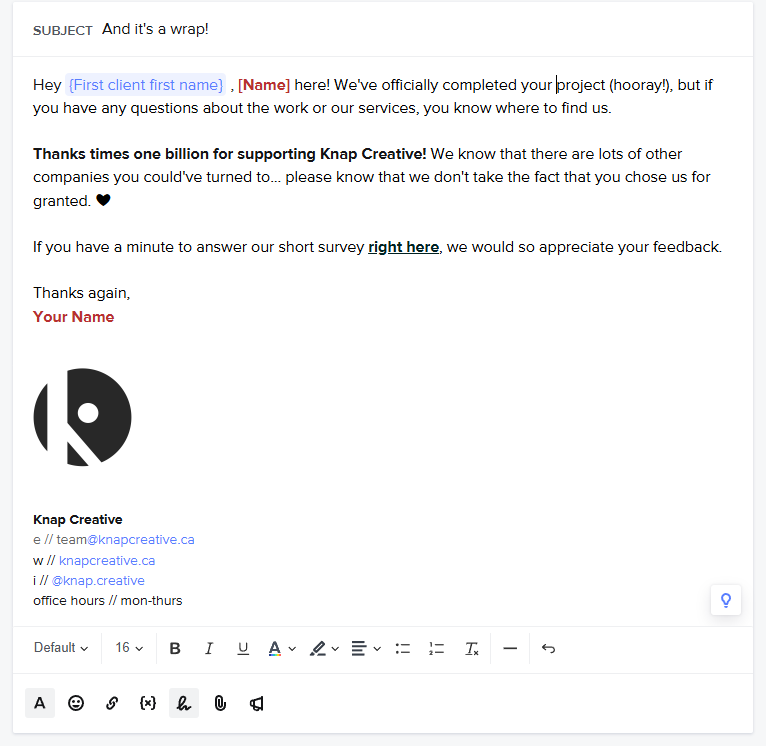Testimonial Strategies That Work: A Practical Guide
Okay, you know and I know that you’re amazing at what you do. But nobody ELSE knows it… yet. It’s time for some testimonial strategies that help you sell! Unless you’re planning on hiring a skywriter to spell out your awesomeness, you’re going to need a little help. Actually, nix the skywriter. It’s going to work a whole lot better if you let other people do the talking.
Testimonials are the sweet, sweet nuggets of trust juice that turn “hmm, maybe?” website visitors into “where do I sign!” clients. In a world where everyone is claiming to be an expert, honest-to-goodness testimonials are The Thing — that’s right, capital Ts. I mean business — that’ll nudge us into buying whatever it is that you’re selling.
Table of Contents
Testimonial Strategies: Before You Start
Before you start asking for testimonials, let’s talk about where they should live. You want maximum bang for your buck, of course. That means you need to collect your testimonials where they can be verified.
We’ve all seen those suspiciously perfect testimonials on websites that look like they were written by the business owner’s best friend, or maybe the business owner themselves. Yuck.
We know that Google & Facebook reviews are legit, so if you start there it helps a ton. (Plus, these verified reviews boost your visibility in search results!) Before you ask for a single testimonial, get one of those places set up and ready to go so they land in the right place right off the hop.
Always respond to reviews, even the negative ones. This shows that you value feedback and are committed to customer satisfaction. A thoughtful response to a negative review can turn a potential detractor into a loyal customer.
Once you have a couple of testimonials, your website is prime real estate — sprinkle them across your landing pages, services page, and even your about page. Make ’em pretty, or just use straight up screen grabs. (Less fussing around and actually more effective, tbh.) Either way, make sure they’re visible!
Don’t just leave testimonials on your website. Use them throughout your sales process! Include relevant testimonials in your email sequences, on your landing pages, and even in your proposals. If you are on a sales call, ask if they have checked out your google reviews.
Testimonial Strategies #1: Get Practical
Just ask!
Seriously, we’re all WAY too shy about asking for testimonials. If you don’t ask, you won’t get them. It’s really that simple. So, when’s the magic moment? And how do you even ask? Let’s break it down.
Strike while the iron’s hot! Right after you’ve knocked their socks off with your amazing service is the perfect time. Think about key milestones: after a client finishes a program, reaches a goal, or completes a project.
Last year, between stuffing my face with leftover pie and contemplating New Year’s resolutions, I sent out a simple email to my clients. Boom! Half a dozen testimonials landed in my inbox. SUCH a fun happy day! Hit ’em when they’re feeling warm and fuzzy (and maybe a little bored).
I’ve also been experimenting with asking for testimonials when I send out invoices. It… well, let’s just say it’s been a learning experience.
It’s easy to think up a brilliant idea and be so disappointed when it doesn’t work, but (1) you have more information; and (2) you’re on the right track! Literally as I’m typing this, I’m realizing I can beef up that invoice email to be more like my holiday email (with a li’l charity donation) and I think it’s going to work like gangbusters!

Now, where to ask? Wherever you’re already communicating with your clients! Email, direct messages, even a quick phone call. If you have an in-person business, a quick, polite request before a client leaves can work wonders!
And how? Keep it personal. Don’t use a generic template — write a quick, friendly message (even if it’s a canned template). Be specific. ‘Hey, I’m so glad you enjoyed your session! Would you mind leaving a quick review on Google?’ is way better than ‘Leave a review if you want.’
Make it easy! Include direct links to your Google or Facebook review pages. This is a CRUCIAL.
Consider offering a gentle prompt. ‘What was the biggest benefit you got from working with me?’ or ‘Would you recommend me to your friends?’ can help them get started. Give us direction. We love direction.


Bottom line: Don’t overthink it. A simple, genuine request goes a long way. Don’t be afraid to ask for video testimonials. They’re incredibly powerful! Seeing and hearing a real person talk about their positive experience adds a layer of authenticity that text alone can’t replicate. Even a short clip from a client’s phone is gold. To make the process even easier, create a testimonial request template. This will save you time, and make sure you are asking all of the correct questions.
Testimonial Strategies #2: Automate (buuuuut don’t be a robot)
I know you’re busy and trying to remember to run after testimonials just feels like one more (kinda stressful) thing tacked onto the bottom of your to-do list. That’s where automation comes in! Remember though, we’re aiming for ‘friendly pro,’ not ‘cold, corporate robot.’
- Post-Purchase Emails:
- Set up automated emails that go out a few days after you’ve delivered your service. A simple ‘How’d we do?’ e-mail with a link to your review page can work wonders.
- Personalize the email as much as possible. Pull in their name FOR SURE, and if you can mention the specific service they received, even better!
Sample 1:

Sample 2:

- Follow-Up Sequences:
- If someone doesn’t leave a review after your initial request, consider a gentle follow-up. A simple ‘Just checking in’ email can be enough to jog their memory. Don’t worry, you’re not being annoying!
Remember: Automation is your friend, but don’t let it replace genuine human interaction. Always make sure your requests feel personal and sincere.
Testimonial Strategies #3: Incentives (use sparingly)
Okay, this one’s a bit of a tightrope walk. Incentives can be a great way to nudge people, but — fine, I’ll say it like it is, you’re bribing them. 😂 Just remember to always be upfront about any incentives you’re offering, and never offer incentives for positive reviews only.
I’m not going to lie, I’m literally fueled by compliments – but ALL feedback is good feedback. Use incentives as a gentle nudge, not a heavy-handed push for empty compliments. Your goal is genuine feedback, the kind that helps you grow and improve.
If you choose to use bribery / incentives, consider offering a small discount on our next purchase or a bonus perk for leaving a review. It doesn’t have to be outrageous — a 10% discount or a free add-on is usually enough!
Another option is to donate a small amount to a charity for every review received, which allows your clients to feel good about leaving a review. This worked really well for me in my holiday email last year!
You can also offer a ‘review for a review,’ where you agree to leave a review for them in exchange for them leaving one for you. This works especially well for fellow service providers or businesses in complementary fields.
Testimonial Strategies #4: No glowing testimonials? No problem.
You’re not out of the game! You can still build credibility even if you don’t have a track record of testimonials (no, seriously!). It’s all about working with what you have.
1. Share stats
If you can’t name-drop clients or share full reviews, let the numbers do the talking.
Example:
“Over 40 private practice owners have partnered with me to rewrite their websites and raise their rates — without burning out.”
“90% of my clients book more calls within two weeks of launching their new homepage.”
2. Call it out
Transparency builds trust. If you don’t have public reviews due to confidentiality, say so — and turn it into a strength.
Example:
“Wondering where all the glowing reviews are? You won’t find them here — because confidentiality is core to what I do. But here’s what I can share…”
→ Follow up with results, anonymized quotes, or “What clients often tell me” style pull-quotes.
3. Use casual praise
Sometimes the best proof is the unfiltered kind. Screenshot a Slack message. Quote a DM. Use that voice-note-style love they send when your work hits just right.
Example:
“This message popped up the day her homepage went live: ‘Bahhh I’m OBSESSED. How is this even mine?!’”
Even a single sentence can add credibility — especially when paired with a tiny backstory.
Your goal isn’t to fake it… it’s to FRAME it.
You don’t need a hundred testimonials to be seen as credible. You just need to be strategic with what you do have.
So whether you’re new to the industry or working in a hush-hush niche, show that you’re observant, capable, and confident in your craft.
People aren’t looking for perfection — they’re looking for someone grounded, real, and ready!
The Bottom Line
Testimonials are your bread & butter. Set up Google and Facebook reviews, ask your happy clients, and sprinkle those reviews everywhere. Automate, incentivize wisely, and remember: genuine feedback is gold.
Don’t overthink it—just start asking!




